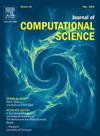A phenomenological discrete model for cardiac tissue mechanics
IF 3.7
3区 计算机科学
Q2 COMPUTER SCIENCE, INTERDISCIPLINARY APPLICATIONS
引用次数: 0
Abstract
This study introduces a simulator for replicating cardiac contraction using a mass–spring system, chosen for its simplicity and computational efficiency. Our phenomenological model’s validity was established by comparing it with finite element method (FEM) based simulators, employing a cardiac mechanics benchmark comprising three distinct experiments. Comparative metrics such as shear, strain, and volume preservation were employed. During the systolic phase, discrepancies between the mass–spring and FEM models ranged from 1 to 5% (depending on the metric). Good agreement was also observed across a complete cardiac cycle. The most notable disparity between the models occurred during the experiment simulating significant heart inflation, ranging from 3 to 13% based on the comparison metric. Furthermore, the mass–spring model exhibited an execution time over seven times faster than the FEM-based model. In conclusion, our work presents a novel phenomenological model for cardiac contraction employing a computationally efficient spring-mass system. This characteristic is particularly pertinent for generating patient-specific models and digital twins.
心脏组织力学的现象学离散模型
本研究介绍了一种使用质量弹簧系统复制心脏收缩的模拟器,选择它是因为它的简单性和计算效率。我们的现象学模型的有效性是通过将其与基于有限元法(FEM)的模拟器进行比较来确定的,该模拟器采用了由三个不同实验组成的心脏力学基准。采用了剪切、应变和体积保存等比较指标。在收缩阶段,质量-弹簧模型和有限元模型之间的差异在1%到5%之间(取决于度量)。在整个心脏周期中也观察到良好的一致性。模型之间最显著的差异发生在模拟显著心脏膨胀的实验中,根据比较指标,差异从3%到13%不等。此外,质量弹簧模型的执行时间比基于有限元的模型快7倍以上。总之,我们的工作提出了一个新的现象学模型的心脏收缩采用计算效率高的弹簧质量系统。这个特性特别适用于生成特定于患者的模型和数字双胞胎。
本文章由计算机程序翻译,如有差异,请以英文原文为准。
求助全文
约1分钟内获得全文
求助全文
来源期刊

Journal of Computational Science
COMPUTER SCIENCE, INTERDISCIPLINARY APPLICATIONS-COMPUTER SCIENCE, THEORY & METHODS
CiteScore
5.50
自引率
3.00%
发文量
227
审稿时长
41 days
期刊介绍:
Computational Science is a rapidly growing multi- and interdisciplinary field that uses advanced computing and data analysis to understand and solve complex problems. It has reached a level of predictive capability that now firmly complements the traditional pillars of experimentation and theory.
The recent advances in experimental techniques such as detectors, on-line sensor networks and high-resolution imaging techniques, have opened up new windows into physical and biological processes at many levels of detail. The resulting data explosion allows for detailed data driven modeling and simulation.
This new discipline in science combines computational thinking, modern computational methods, devices and collateral technologies to address problems far beyond the scope of traditional numerical methods.
Computational science typically unifies three distinct elements:
• Modeling, Algorithms and Simulations (e.g. numerical and non-numerical, discrete and continuous);
• Software developed to solve science (e.g., biological, physical, and social), engineering, medicine, and humanities problems;
• Computer and information science that develops and optimizes the advanced system hardware, software, networking, and data management components (e.g. problem solving environments).
 求助内容:
求助内容: 应助结果提醒方式:
应助结果提醒方式:


